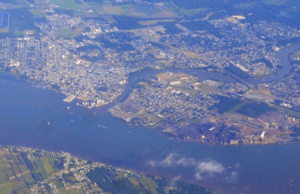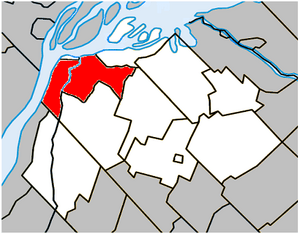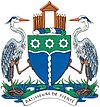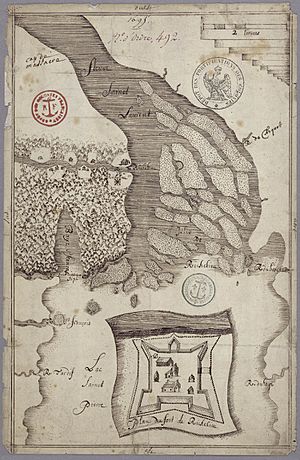Sorel-Tracy facts for kids
Quick facts for kids
Sorel-Tracy
|
||
|---|---|---|
|
City
|
||
| Ville de Sorel-Tracy | ||

Aerial view of Sorel-Tracy
|
||
|
||

Location within Pierre-De Saurel RCM.
|
||
| Country | ||
| Province | ||
| Region | Montérégie | |
| RCM | Pierre-De Saurel | |
| Constituted | March 15, 2000 | |
| Area | ||
| • Land | 57.28 km2 (22.12 sq mi) | |
| • Urban | 30.61 km2 (11.82 sq mi) | |
| • Metro | 170.31 km2 (65.76 sq mi) | |
| Population
(2021)
|
||
| • City | 35,165 | |
| • Density | 614/km2 (1,590/sq mi) | |
| • Urban | 36,650 | |
| • Urban density | 1,197.3/km2 (3,101/sq mi) | |
| • Metro | 41,934 | |
| • Metro density | 246.2/km2 (638/sq mi) | |
| • Pop 2016–2021 | ||
| • Dwellings | 17,069 | |
| Time zone | UTC−5 (EST) | |
| • Summer (DST) | UTC−4 (EDT) | |
| Postal code(s) |
J3P-J3R
|
|
| Area code(s) | 450 and 579 | |
| Highways |
||
Sorel-Tracy is a city in southwestern Quebec, Canada. It is located where the Richelieu River meets the St. Lawrence River. This area is also the end point of the Champlain Valley. The city is found on the western edge of Lac Saint-Pierre, northeast of Montreal.
In 2021, the population of Sorel-Tracy was 35,165 people. The current mayor is Patrick Péloquin. Sorel-Tracy is the main city for the Pierre-De Saurel Regional County Municipality. It is also an important center for the judicial district of Richelieu.
The city of Sorel-Tracy was formed in March 2000. This happened when two older towns, Sorel and Tracy, decided to merge. They were located on opposite sides of the Richelieu River. Tracy was on the west side, and Sorel was on the east side. Sorel had already joined with Saint-Pierre-de-Sorel in 1992.
Sorel was founded a long time ago, in 1642. Tracy was officially founded on February 10, 1954. Before that, it was a parish municipality called Saint-Joseph de Sorel. This is different from the nearby town of Saint-Joseph-de-Sorel, which is still a separate municipality.
Sorel-Tracy is well-known for its factories that work with steel and metals. A ferry connects the city to the village of Saint-Ignace-de-Loyola. The city's shipyard has built ships for the Canadian forces, including parts for three frigates.
Contents
History of Sorel-Tracy
Early Beginnings and Conflicts
When French explorers first came to this area, it led to fights with different First Nations. The French learned about rivalries between these groups. They tried to make alliances with some First Nations.
A famous battle, the Battle of Sorel, happened on June 19, 1610. Samuel de Champlain and his French soldiers, along with their allies from the Wyandot, Algonquin, and Innu peoples, fought against the powerful Mohawk people. This battle took place in New France.
Sorel is the fourth oldest city in Quebec. It began in 1642 when Charles Huault de Montmagny, the first Governor of New France, built Fort Richelieu. This fort was built to protect settlers and travelers on the river from attacks by the Iroquois, especially the Mohawk.
The Mohawk people destroyed the first fort in 1647. But it was rebuilt in 1665 by the Carignan-Salières Regiment in the same spot.
How Sorel-Tracy Got Its Name
The name Sorel comes from Pierre de Saurel. He was the first seigneur (lord) of the area. He led a company of the Carignan-Salières Regiment that arrived in New France in August 1665. King Louis XIV gave him the land in 1672. He had already built a manor house four years earlier.
The parish of Tracy was named after Lieutenant General Alexander de Prouville, Sieur de Tracy. He was the overall commander of the Carignan-Salières Regiment.
After Prince William Henry visited Sorel in 1787, the town was called William-Henry. It kept this name until 1845.
Sorel During the American Revolution
Before the American Revolution, most people in Sorel were French-speaking Catholics. During the war, many troops passed through or stayed in Sorel. The English, for example, housed German soldiers they had hired there.
In 1778, Governor Frederick Haldimand suggested making Sorel a strong military base. He also wanted the King to buy the land. The Crown bought the land in 1781, at the end of the war.
Sorel then became a place for Loyalist refugees from the south. Loyalists were people who supported the British during the American Revolution. Many of them settled in Sorel. The town also became a station for "Military Invalids," who were older veterans.
Religious and Social Changes
The first efforts to establish the Protestant religion in Lower Canada began in Sorel. In 1783, the settlers asked the Anglican Church to send a minister. Reverend John Doty arrived in Sorel on July 4, 1784. This date marks the start of the Anglican parish in Sorel. It was the first Anglican mission in Canada.
In the early 1800s, Sorel was a center for fur traders. Over time, more permanent settlers arrived, changing the town.
In the 1820s, Sorel was home to the governor's house for the Governor General of Lower Canada, Lord Dalhousie. His presence made the town a center for the politics of that time. This was before the Lower Canada Rebellion.
Locally, the governor and the Catholic parish priest Jean-Baptiste Kelly had influence. Kelly helped improve the town in many ways. The old parsonage was rebuilt in stone by 1832. In 1845, the town changed its name back to Sorel from William-Henry. This showed its French Catholic population.
Kelly also helped improve the parish library. By 1846, it had four hundred books. In 1848, the community put up a monument for temperance (avoiding alcohol). They also started a group to help the poor and sick, and to educate girls.
Shipbuilding in Sorel
The shipyards in Sorel have always been important for its economy. In the late 1900s, the city helped build three of the 12 Halifax-class frigates for the Canadian Forces. These ships were the HMCS Ville de Québec, HMCS Regina, and HMCS Calgary.
The shipyard in Sorel-Tracy was called M.I.L. Tracy. It built parts for these three ships. These parts were then sent by barge for final assembly at M.I.L. Davie in Lauzon, Quebec.
Before these frigates, MIL built HMCS Nipigon, which was launched in 1964. MIL also built HMCS Bras d'Or. This was an experimental hydrofoil ship for the Royal Canadian Navy.
Economy and Jobs
Sorel-Tracy has several important industries. The city is home to the Tracy Thermal Generating Station, which produces electricity.
The city's shipyard has a long history of building ships, including many for the Royal Canadian Navy.
QIT-Fer et Titane is another major company in Sorel-Tracy. It is a Titanium smelter and refinery, now owned by the Rio Tinto corporation. This means they process titanium ore into useful metals.
Getting Around Sorel-Tracy
Sorel-Tracy is about 75 kilometers (47 miles) from both Montreal and Trois-Rivières. It is easy to reach by car using Autoroute 30 from the west. You can also use Route 132 from both the east and west. Autoroute 30 currently stops at Sorel and starts again at Bécancour, so there is a missing part in between.
A ferry runs all year long on the St. Lawrence River. It connects Sorel-Tracy to Saint-Ignace-de-Loyola, which is on the way to Berthierville.
Geography and Weather
Climate in Sorel-Tracy
Sorel-Tracy experiences a humid continental climate. This means it has warm summers and cold, snowy winters.
| Climate data for Sorel-Tracy | |||||||||||||
|---|---|---|---|---|---|---|---|---|---|---|---|---|---|
| Month | Jan | Feb | Mar | Apr | May | Jun | Jul | Aug | Sep | Oct | Nov | Dec | Year |
| Record high °C (°F) | 12.8 (55.0) |
12.0 (53.6) |
21.1 (70.0) |
30.5 (86.9) |
34.4 (93.9) |
37.8 (100.0) |
36.7 (98.1) |
37.8 (100.0) |
33.9 (93.0) |
28.9 (84.0) |
22.8 (73.0) |
14.4 (57.9) |
37.8 (100.0) |
| Mean daily maximum °C (°F) | −6.1 (21.0) |
−4.1 (24.6) |
2.1 (35.8) |
10.5 (50.9) |
18.9 (66.0) |
24.1 (75.4) |
26.6 (79.9) |
25.1 (77.2) |
19.3 (66.7) |
12.3 (54.1) |
4.8 (40.6) |
−2.8 (27.0) |
10.9 (51.6) |
| Daily mean °C (°F) | −11.2 (11.8) |
−9.2 (15.4) |
−2.9 (26.8) |
5.4 (41.7) |
13.1 (55.6) |
18.5 (65.3) |
21.2 (70.2) |
19.7 (67.5) |
14.3 (57.7) |
7.9 (46.2) |
1 (34) |
−7.3 (18.9) |
5.9 (42.6) |
| Mean daily minimum °C (°F) | −16.2 (2.8) |
−14.4 (6.1) |
−7.9 (17.8) |
0.3 (32.5) |
7.2 (45.0) |
12.8 (55.0) |
15.7 (60.3) |
14.3 (57.7) |
9.3 (48.7) |
3.5 (38.3) |
−2.7 (27.1) |
−11.7 (10.9) |
0.9 (33.6) |
| Record low °C (°F) | −41.0 (−41.8) |
−37.8 (−36.0) |
−35.0 (−31.0) |
−28.9 (−20.0) |
−6.1 (21.0) |
−1.7 (28.9) |
4.4 (39.9) |
0.0 (32.0) |
−4.5 (23.9) |
−10.6 (12.9) |
−25.0 (−13.0) |
−40.6 (−41.1) |
−41.0 (−41.8) |
| Average precipitation mm (inches) | 74.3 (2.93) |
60.0 (2.36) |
66.8 (2.63) |
76.0 (2.99) |
85.8 (3.38) |
92.7 (3.65) |
90.9 (3.58) |
93.4 (3.68) |
81.1 (3.19) |
87.5 (3.44) |
89.3 (3.52) |
78.3 (3.08) |
976.1 (38.43) |
| Source: Environment Canada | |||||||||||||
People of Sorel-Tracy
In the 2021 Census, Sorel-Tracy had a population of 35,165 people. This was a small increase of 1.2% from its 2016 population. The city covers a land area of 57.28 square kilometers.
Most of the people in Sorel-Tracy are French Canadian. They make up more than 90% of the population. Less than 7% of the people were born outside Canada or are second-generation immigrants. Anglo-Canadians make up less than 2% of the people living in Sorel-Tracy.
|
Population Growth:
|
Main Languages Spoken (2021)
|
Sports in Sorel-Tracy
The city is home to the historic Colisée Cardin. This ice hockey arena was built in 1954. The Sorel Éperviers hockey team played there from 1969–77 and again in 1980–81. In 1974, they reached the league final for the President's Cup (QMJHL), but lost to the Quebec Remparts.
Since 1996, Sorel-Tracy has had a team in the LNAH (a hockey league). The team has had different names over the years, like Dinosaures and Mission. In 2012, they became the Sorel-Tracy Éperviers.
Famous People from Sorel-Tracy
Many talented people come from Sorel-Tracy, including:
- François Beauchemin: An ice hockey defenseman who won the Stanley Cup with the Anaheim Ducks in 2007.
- Anthony Beauvillier: An ice hockey left winger who plays in the NHL.
- Danic Champoux: A documentary filmmaker.
- Maryeve Dufault: A racing driver.
- Nicolas Aubé-Kubel: An ice hockey right winger who won a Stanley Cup with the Colorado Avalanche in 2022.
- Marc-André Fleury: A famous goaltender in the National Hockey League. He won three Stanley Cups with the Pittsburgh Penguins.
- Andre Gill: An ice hockey goaltender.
- Claude Lagacé: An organist.
- Pierre Mondou: An ice hockey center who won three Stanley Cups with the Montreal Canadiens.
- Jean Morin: A retired ice hockey linesman.
- Pierre Paquette: A politician and member of the Bloc Québécois.
- LuFisto: A professional wrestler.
- Monique Régimbald-Zeiber: A painter.
See also
 In Spanish: Sorel-Tracy para niños
In Spanish: Sorel-Tracy para niños




